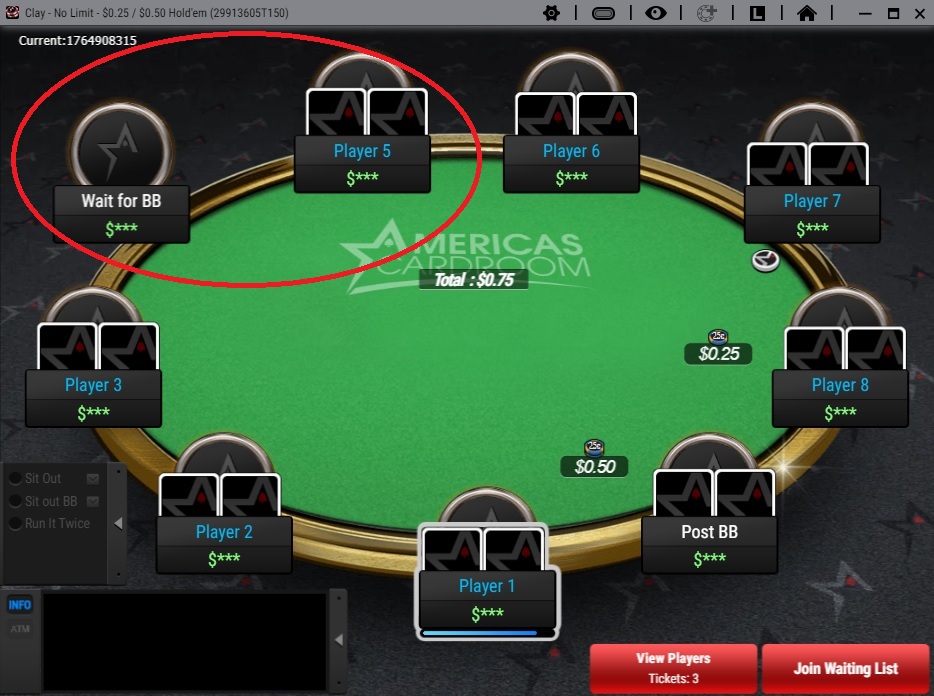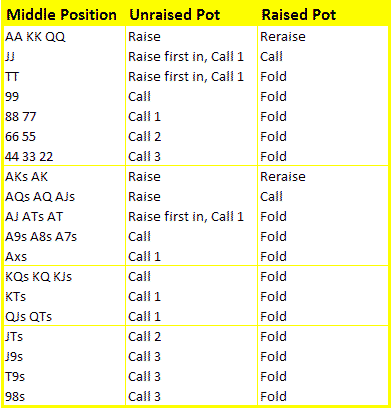
When you’re playing Texas Hold’em from a middle position, you have a bit more flexibility than in an early position, but you’re still not in an ideal spot since there are players who will act after you. Your strategy should strike a balance between the tight play necessitated by an early position and the wider range of hands that you can play from a late position.
Middle position in Texas Holdem refers to the seats after UTG+2. The seat to the left of UTG+2 is also called Lojack and the seat to the left of that is called Hijack. These two seats make up the middle position. In the graphic above, you’ll see these seats are occupied by Player 4 and Player 5.
Here is a good way to play your middle position, check out our middle position hand chart below:
Middle Position Hand Chart

Understanding the Middle Position Hand Chart
The first column gives you a list of playable hands from middle position. Any other hands you would instantly fold. How you play your hand depends on the action in front of you. The second column gives you directions if no one has raised the pot before you (but may have called so they are playing), and third column is the action if someone has raised the pot before you. For example, if you are holding KQ in middle position, you would raise if no one has entered the pot before you. If one person has entered the pot before you, you would call. If someone has raised the pot before you, you would fold. This is an example of the same hand having three different actions depending on what happens in earlier positions.
Here are some general tips to help you navigate playing from a middle position:
Loosen Up A Bit: While you still want to play relatively tight, you can afford to loosen up a bit compared to an early position. In addition to high pairs and big aces, you can start to add more hands to your range, like medium pairs, suited connectors, and occasionally suited one-gappers. Hands like 88, AJ, KJs become playable in middle position. If no one has raised before, you can even come in with a raise and narrow down the field. If you get re-raised behind you, then consider folding!
Be Aggressive With Strong Hands: If you have a strong hand, be aggressive. Raise or re-raise if there’s been a raise in front of you. Building the pot when you have a strong hand will yield bigger rewards if you win.
Consider The Action Before You: Pay attention to what the players in the early position are doing. If there’s a raise in front of you, be cautious about re-raising unless you have a very strong hand. If the early position players fold and you have a decent hand, consider raising to try and take down the blinds.
Consider The Players After You: Keep in mind the playing styles of the players who will act after you. If they’re very aggressive, you may want to play a bit tighter to avoid getting re-raised. Conversely, if they’re passive or tight, you can afford to play a bit looser.
Don’t Be Afraid To Fold: Middle position still isn’t ideal, so if there’s a raise and a re-raise in front of you, or if you raise and get re-raised, don’t be afraid to fold unless you have a premium hand. Remember, it’s better to lose a small amount than a big one.
Be Prepared To Play After The Flop: If you do see the flop, be ready to play poker. You’ll need to consider not just the strength of your hand, but also the tendencies of your opponents, the size of the pot, and the potential of your hand to improve on the turn and river.
Consider Stack Sizes: Just like in early position, pay attention to stack sizes. If you or an opponent has a short stack, it can greatly influence how you should play certain hands.
By incorporating these strategies into your game, you can navigate playing from a middle position more effectively. Remember, these are general guidelines and it’s important to adjust your strategy based on the specific circumstances of each hand.
Leave a Review
Submit your review | |







